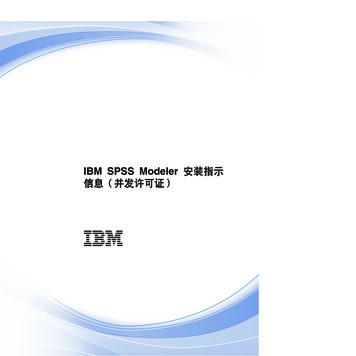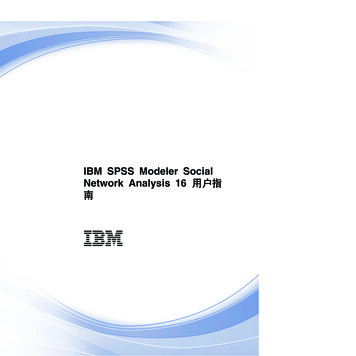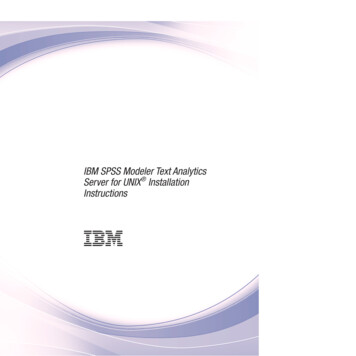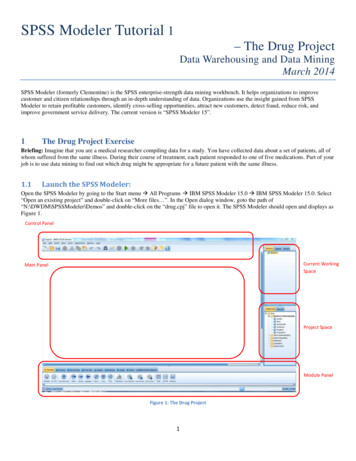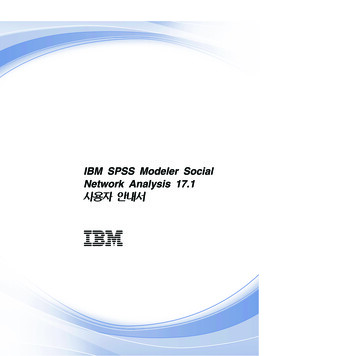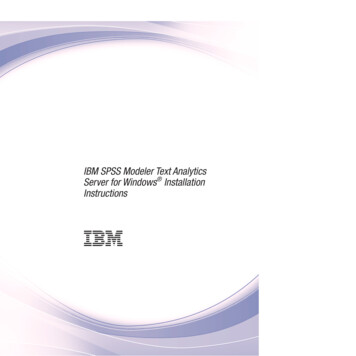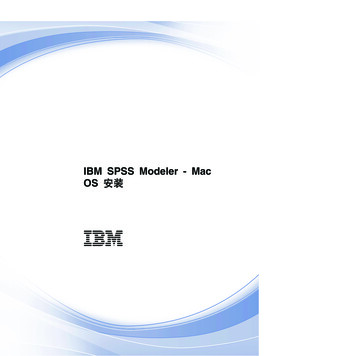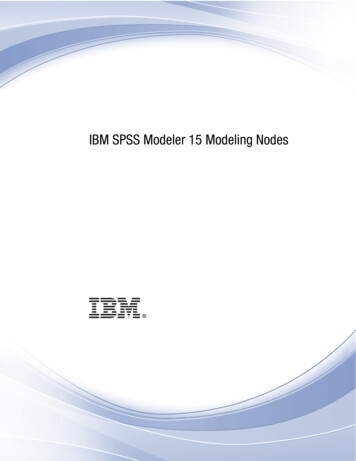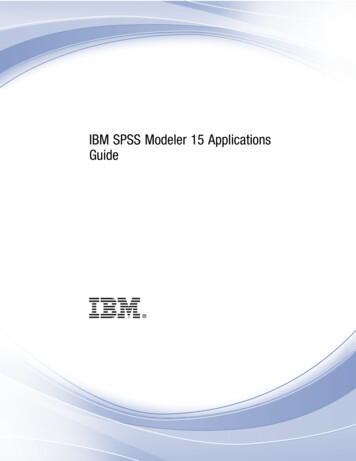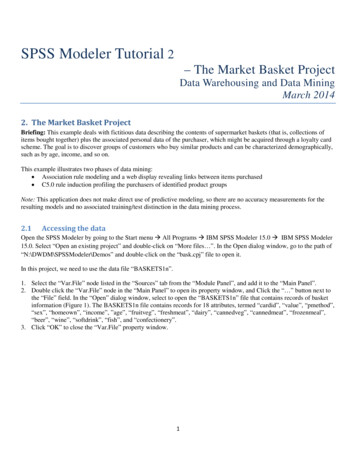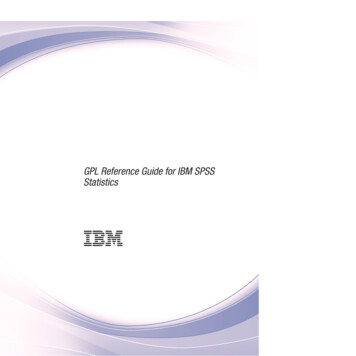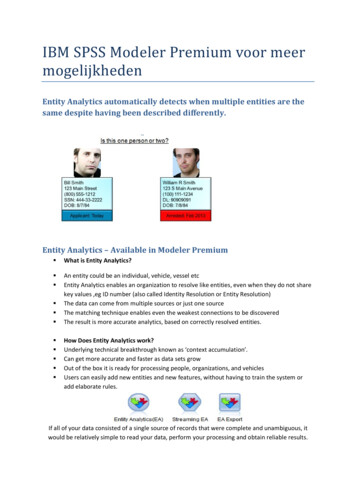
Transcription
IBM SPSS Modeler Premium voor meermogelijkhedenEntity Analytics automatically detects when multiple entities are thesame despite having been described differently.Entity Analytics – Available in Modeler Premium What is Entity Analytics? An entity could be an individual, vehicle, vessel etcEntity Analytics enables an organization to resolve like entities, even when they do not sharekey values ,eg ID number (also called Identity Resolution or Entity Resolution)The data can come from multiple sources or just one sourceThe matching technique enables even the weakest connections to be discoveredThe result is more accurate analytics, based on correctly resolved entities. How Does Entity Analytics work?Underlying technical breakthrough known as ‘context accumulation’.Can get more accurate and faster as data sets growOut of the box it is ready for processing people, organizations, and vehiclesUsers can easily add new entities and new features, without having to train the system oradd elaborate rules.If all of your data consisted of a single source of records that were complete and unambiguous, itwould be relatively simple to read your data, perform your processing and obtain reliable results.
However, in the real world . the picture is usually very different. Data is typically far from complete,frequently ambiguous, and often scattered over many different data sources, recording manydifferent attributes with few overlapping fields.Quite often individuals are not recognized as the same person or entities are inaccurately associatedwhen combining data from various sources. A further challenge is when individuals intentionally tryto mask who they are and what they are doing, with different names or addressesEntity Analytics provides organizations with the ability to more accurately recognize and identifyentities (whether they are individuals, vehicles, vessels etc) and resolve conflicts, prior to statisticaland predictive analysis.In fact, the more data there is to analyze and the more diverse the data sources are the better theresults, which in turn improves the accuracy of the predictive modeling.The ability to resolve entity conflicts is crucial for industries where the quality of the data needs to beas accurate as possible and the predictive models accuracy is critical. Areas such as border security,fraud detection, money laundering criminal identification are areas that immediately come to mind.This is also useful for improving customer relationship management, ensuring you are not sendingduplicate marketing offers to the same person because of data that has not been cleansed properly.Now lets look at a fictitious example to better illustrate entity analytics.Entity Analytics uses “Context Accumulation” to Find Deeper Insights
IBM SPSS Entity Analytics Delivers General Purpose “ContextAccumulation”Entity Analytics – Analyze the Data in the RepositoryWith at least one data source input to the repository, you can use the Entity Analytics(EA) sourcenode to pass the resolved identities to other IBM SPSS Modeler nodes for further analysis orprocessing, such as creating a report listing the resolved identities EA‐IDEntity identifier EA‐SRCSource tag identifying the data source where the records originated EA‐KEYField designated as unique key in data source fileWhereas the export node outputs records for all the entities related to its input records, theStreaming EA node outputs records for only those entities that relate to entities already resolved inthe repository
Entity Analytics – Application for CreditThis person Elizabeth Lisa Johns is applying for a loan, and her application details are listed. Sheclaims to have no previous defaults and has a debt–to‐income ratio of 17.3 .Now if our loan policy was to approve those applications where there was no previous defaulthistory and the debt to income ratio was below 25. We could approve this loan and Elizabeth wouldbe on her way with our money.
Entity Analytics Enhancements Support for RelationshipsAs well as resolving individual entities this can now identify n‐degree relationships between entities.STBS are basically bins of location and timestamp data that allow you to monitor times and placeswhere entities dwell – could be used for example in tracking shipments in time and space. This is oneof a series of new things we will be doing in relation to geospatial and temporal‐spatial.Entity Analytics – Map Data Fields to the Repository Features
This procedure may vary, but generally you would Read the source dataConnect to the EA repository. The repository provides a central storage area, acting as a datacache for all of the entity information.Map the data fields to repository features so it understands which fields could relate to eachother (eg name, address etc)Export the data into the repository and resolve the identitiesAnalyze the resolved identities from the repositoryOr resolve new cases against the repositoryGenerate any necessary alerts (batch or real‐time)Text Analytics within IBM SPSS Modeler
Text Analytics Extracts Concepts and Patterns from TextText Analytics Identifies the Context/Sentiment of the Text
Comparison of Text Analytics with SPSS Text Analytics for SurveysA prospect should generally use STAfS: If they want to quantify survey text. If they want to work with relatively small data sets (optimized to process data sets of up to 10,000records). If desktop only is required (since there is no server version). If they want to work in conjunction with SPSS Statistics and/or Excel, but not SPSS Modeler. If they do not need to work directly with SPSS C&DS. If they do not want to work with RSS feeds.A prospect should generally use SPSS Modeler Premium: If they want to create a predictive model. If they want to work with relatively large data sets (server version is available for bigger jobs). If desktop and server versions are required. If they already have SPSS Modeler or have other uses for it/reasons to buy it. If they do need to work directly with SPSS C&DS. If they want to work with RSS feeds. If they want to analyze entire folders (corpus) of data. If they want to import many different file types (e.g. DOC, PPT, TXT, PDF).
Social Network Analysis Applications Churn Prediction Group characteristics can influence churn rates Focus on individuals in groups with an increased risk of churn Identify individuals that are at risk of churning due to the flow of info from those thatalready churned.Leveraging Group Leaders Group leaders are highly influential over other group members Prevent a group leader from churning to decrease the churn rate for other groupmembers Acquire a group leader from a competitor to increase the churn rate that group.Marketing Use Group leaders to initiate new goods or service offerings.Many approaches to modeling behavior focus on the individual. They use a variety of data aboutindividuals to generate a model that uses the key indicators of the behavior to predict it. If anyindividual has values for the key indicators that are associated with the occurrence of the behavior,that individual can be targeted for special attention designed to prevent the behavior.Consider approaches to modeling churn, in which a customer terminates his or her relationship witha company. The cost of retaining customers is significantly lower than the cost of replacing them,making the ability to identify customers at risk of churning vital. An analyst often uses a number ofKey Performance Indicators to describe customers, including demographic information and recentcall patterns for each individual customer. Predictive models based on these fields use changes incustomer call patterns that are consistent with call patterns of customers who have churned in thepast to identify people having an increased churn risk. Customers identified as being at risk receiveadditional customer service or service options in an effort to retain them.These methods overlook social information that may significantly affect the behavior of a customer.Information about a company and about what other people are doing flows across the relationshipsto impact people. As a result, relationships with other people allow those people to influence aperson’s decisions and actions. Analyses that include only individual measures are omittingimportant factors having predictive capabilities.SPSS Modeler Social Network Analysis addresses this problem by processing relationship informationinto additional fields that can be included in models. These derived key performance indicatorsmeasure social characteristics for individuals. Combining these social properties with individual based measures provides a better overview of individuals and consequently can improve thepredictive accuracy of your models.
Social Network Analysis Processes CDR (Call Data Record) data from Telecommunications companiesIdentifies groups, leaders and probabilities that others will churn based on influenceEnhances existing churn predictions of ModelerExpressed as two new nodes in the Sources Palette Group Analysis: identify the groups in the data and who are the leaders of them Diffusion Analysis: use existing churn information to determine who else thatchurner is likely to influence to leave
Text Analytics within IBM SPSS Modeler Text Analytics Extracts Concepts and Patterns from Text Text Analytics Identifies the Context/Sentiment of the Text Comparison of Text Analytics with SPSS Text Analytics for Surveys A prospect should generally use STAfS: If they want to quantify survey text.
